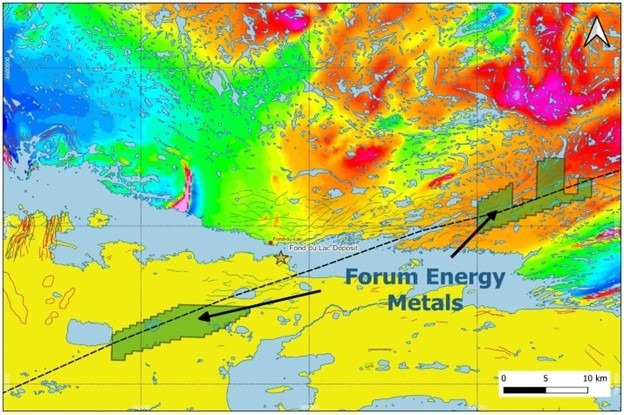Together with Forum Energy Metals Corp., Traction Uranium Corp. has begun an aerial magnetic, electromagnetic (EM), and radiometric survey on the 100%-owned Grease River Project in Saskatchewan’s Athabasca Basin.
 Location of the Grease River Project in northern Saskatchewan nearby the community of Fond-du-Lac. The southern claim block is in Athabasca Basin sandstone cover (yellow) and the northern block is in basement rocks (shown with background magnetics). Dashed line is the Grease River Shear Zone. Image Credit: Traction Uranium Corp.
Location of the Grease River Project in northern Saskatchewan nearby the community of Fond-du-Lac. The southern claim block is in Athabasca Basin sandstone cover (yellow) and the northern block is in basement rocks (shown with background magnetics). Dashed line is the Grease River Shear Zone. Image Credit: Traction Uranium Corp.
A specifically created Xcite™ Time Domain Electromagnetic System by New Resolution Geophysics will be used for the helicopter-borne survey. The 10,528 hectares of Grease River claims totaling 1,290 line km will be surveyed along the Grease River Shear Zone at a line spacing of 100 m.
Traction and Forum entered into an option agreement under which Traction is granted the right to purchase a 51% interest in the Property by making a total payment of $250,000, issuing a total of 1,625,000 common shares, and funding a total of $3 million in exploration costs on the Property by December 31st, 2025. The Operator during this First Option Period is Forum.
Traction also has the option to acquire up to a 100% stake in the project by investing $6 million in exploration, $1.7 million in cash payments, and 5.5 million in share payments up until December 31st, 2028. In addition to $8 million in milestone payments, Forum would keep its 2% Net Smelter Return Royalty.
The Grease River Project
The Grease River Project is situated close to Fond du Lac in the north-central portion of the Athabasca Basin. The Grease River Project comprises two distinct claim blocks located along the primary intracontinental shear zone with a length of more than 400 km, the NE-trending Grease River Shear zone.
The nearby Fond du Lac uranium deposit was first discovered within the shear zone by Amok Ltd. and Eldorado Nuclear Ltd. in the 1970s, and a historical resource estimate of one million pounds of uranium at an average grade of 0.25% U3O8 was included that was not prepared in accordance with National Instrument 43-101-Standards of Disclosure for Mineral Projects.
Despite the fact that Amok/Eldorado, seasoned mineral resource companies, and the quality of the historical work completed believe the historical estimate to be relevant and reliable, a qualified individual has not performed sufficient work to verify and classify the historical estimate as a current mineral resource, so the company is not treating the historical estimate as a current mineral.
As a result, it is not advisable to rely on the historical estimate. The company further points out that the claims in the Grease River Project are situated along the deposit’s trend to the southwest and northeast. The Grease River Project region has seen limited exploration.